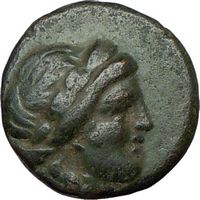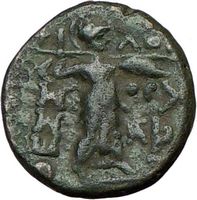Thessalian League Confederacy of Thessaly in
Ancient Greece History and Authentic Greek Original Coins for Sale
Own certified authentic ancient greece coins of Thessalian League
Confederacy
Get the best deals on ancient coins from www.TrustedCoins.com. All
coins come with a certificate of authenticity and a lifetime
guarantee of authenticity, provided by expert numismatist, dealer and
enthusiast of ancient coins, Ilya Zlobin. You can
explore a selection of other emperor and empress coins by visiting the
chronological list of every emperor and empress of
the Roman empire. Ancient coins make a great gift, investment and a
teaching aid to learning history. It is important to deal
with trusted coin dealers, that is why this is the best place for you to
shop online.


Authentic Ancient Coin of:
Greek city of Larissa
Bronze 17mm (6.72 grams) Struck in the Thessalian League City
of Larissa circa 196-146 B.C.
Reference: Sear 2237; B.M.C. 7.50,51
Laureate head of Apollo right.
ΘΕΣΣΑ / ΛΩΝ - behind and before Athena Itonia advancing right,
brandishing spear and holding shield; HP monogram in field to right.
Following the great victory of the Roman general
Flamininus over Philip V of Macedon, in 197 B.C., the freedom of the
Greeks was proclaimed at Corinth and a number of new autonomous coinages
were initiated. Those in the name of the Thessaly were struck probably
at Larissa.
Larissa, sometimes written Larisa on ancient coins
and inscriptions, is near the site of the Homeric Argissa. It appears in
early times, when
Thessaly was mainly governed by a few
aristocratic families, as an important city under the rule of the
Aleuadae, whose authority extended over
the whole district of
Pelasgiotis. This powerful family
possessed for many generations before 369 BC the privilege of furnishing
the tagus, the local term for the
strategos of the combined
Thessalian forces. The principal rivals of the Aleuadae were the
Scopadac of
Crannon, the remains of which (called
by the Turks Old Larissa) are about 14 miles south west. The inhabitants
sided with
Athens during the Peloponnesian War.
As the chief city of ancient Thessaly, Larissa was
directly annexed by Philip II of Macedon in 344, and from then on
Larissa was under Macedonian control; in 196 B.C. Larissa became an ally
of Rome and was the headquarters of the
Thessalian League.
Thessaly was home to an extensive
Neolithic culture around
2500 BC.
Mycenaean settlements have also been
discovered, for example at the sites of
Iolcos,
Dimini and
Sesklo (near
Volos). Later, in
ancient Greek times, the lowlands of
Thessaly became the home of baronial families, such as the
Aleuadae of
Larissa or the Scopads of Crannon.
These baronial families organized a federation across the Thessaly
region, later went on to control the
Amphictyonic League in northern Greece.
The
Thessalians were renowned for their
cavalry.
In the summer of
480 BC , the Persians invaded Thessaly.
The Greek army that guarded the
Vale of Tempe , evacuated the road
before the enemy arrived. Not much later, Thessaly surrendered. The
Thessalian family of
Aleuadae joined the Persians. In the
Peloponnesian War the Thessalians
tended to side with Athens and usually prevented Spartan troops from
crossing through their territory with the exception of the army of
Brasidas.
Jason of Pherae briefly transformed the
country into a significant military power, though he was assassinated
before any lasting achievements were made. In the
4th century BC Thessaly became
dependent on
Macedon and many served as vassals. In
148 BC the Romans formally incorporated
Thessaly into the province of
Macedonia, though in 300 AD Thessaly
was made a separate province with its capital at
Larissa.
It was part of the Byzantine Empire and suffered many
invasions. In 977 it was occupied by the Bulgarians, who remained there
until 1014. In 1204 he was assigned to
Boniface of Montferrat and in 1225 to
Theodore Komnenos Doukas, despot of
Epirus. From 1271 to 1318 he was an
independent despotate that extended to
Acarnania and
Aetolia, run by John III Angelos
Komneno. In 1309 settled there the
Almogavars or
Catalan Company of the East (Societas
Catalanorum Magna), which in 1310, after lifting the siege of
Thessalonica, withdrew as mercenaries in the pay of the
sebastocrátor John II, and took over
the country organized in a democracy. From there went to the
Duchy of Athens called by the duke
Walter I. In 1318, with the extinction of the dynasty of Angelos, the
Almogavars occupied Siderocastron and southern Thessaly (1319) and
formed the
duchy of Neopatria.
Later it was occupied by the
Serbs until 1393, after being dominated
by the
Ottomans. In 1821 participated in the
Greek War of Independence, but was not
recognized as part of
Greece until 1881.
|